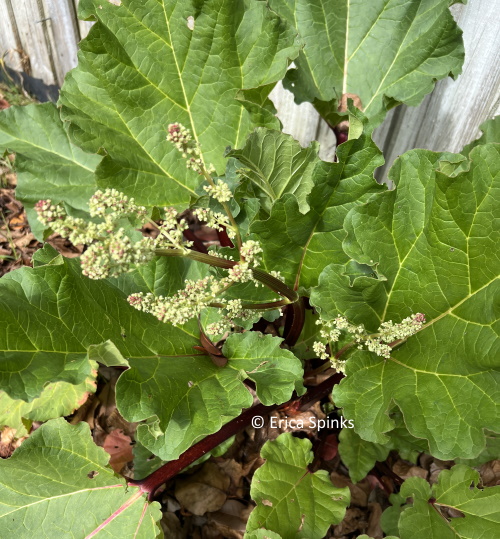I’ve always been entranced by the beauty of well-tended vegetable and fruit gardens. Those surrounded by quirky fences or walled gardens seem so romantic. All that flourishing greenery, just waiting to be harvested and eaten.
Most photos of vegetable gardens found in books and online are shot when the beds are looking at their best, of course. It’s enticing to imagine that you can have such a thriving edible patch in your own garden.
Rhubarb always features in my fantasy vegetable gardens. I’m not sure why – I’ve never eaten any in my life and have no idea what it tastes like. The only things I know is that the plant grows from a crown, the leaves are poisonous, and the stems need lots of sugar to make them edible. Not really enticing, is it?
Still, I was thrilled to discover my new garden had two well-established rhubarb plants. They looked happy and, for the past two years, I’ve simply pulled off dead leaves and otherwise left them alone. Until this week, when one of them sent up flower spikes. I decided it was time to find out more about rhubarb.

Rhubarb is a perennial that normally stays in the same position for years, although the crown can be divided in late winter every five or so years to create new plants. It likes a sunny spot where it can spread out, but doesn’t like hot afternoon sun. The plant likes water and regular boosts of fertiliser in the growing season.
Harvesting is easy – simply snap off stems at the base (don’t cut) and don’t take more than half the stems at any one time. It sounds like a useful plant to have in the garden. I found some recipes for rhubarb stalks on taste.com.au Maybe I’ll try some – the pear, strawberry and rhubarb crumble sounds tasty!
You can also make an insecticide with the leaves (remember, they are poisonous) by boiling one part leaves with 10 parts water, then add a small amount of soap and strain. I haven’t tried this but I’ve read it can be used as a spray against aphids, whiteflies and caterpillars.
But back to my flower spikes. I’m going outside now to cut them off so they don’t take energy from the plant. Sorry, rhubarb!
Thank you have found this article helpful . I have just been given rhubarb crowns, although it will be awhile before they are ready for the cooking pot.
Also enjoy your quilting articles
Thanks Roslyn. Are you still quilting?
Yes still quilting however moved last year so quilting has been on hold. However many projects still in my head waiting to be started.
Moving house has brought emphasis to the garden, which I have revamped hence the rhubarb comment.
Thank you for all your garden tips and tales which I enjoy
Thanks for your kind words Roslyn. Enjoy your garden! 😀